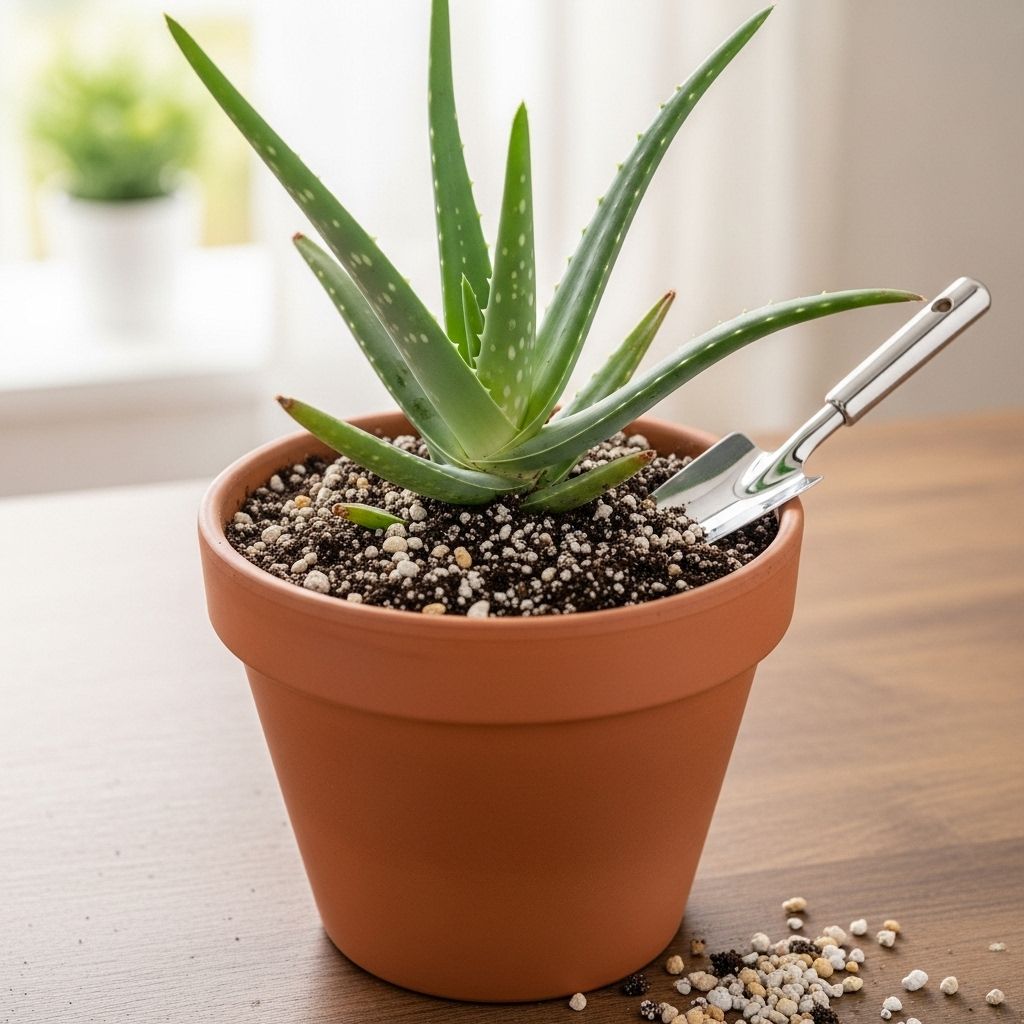Best Soil For Aloe Vera: Expert Tips For A Well-Draining Mix
Master the art of growing vibrant aloe vera with the perfect soil mix, drainage strategies, and pro care tips for thriving succulents.

Image: HearthJunction Design Team
Aloe Vera Soil: The Foundation for Healthy and Thriving Succulents
Aloe vera is celebrated for its soothing gel and remarkable resilience, but did you know that the secret to its health and vigor lies beneath the surface? Choosing the right soil for aloe vera is the single most important factor to growing a robust plant. This comprehensive guide explores the essential components of aloe vera soil, key care strategies, and expert tips for mixing and maintaining the ideal substrate for your succulents—both indoors and outdoors.
Why the Right Soil Matters for Aloe Vera
Native to arid regions, aloe vera evolved to thrive in sandy, gritty soils with minimal water retention. Unsuitable soil can spell disaster for your aloe, leading to root rot, stunted growth, or pest susceptibility. Understanding aloe’s natural habitat helps you replicate optimal conditions at home, ensuring your plant remains green, firm, and bursting with vitality.
Characteristics of Ideal Aloe Vera Soil
- Excellent Drainage: Aloe roots are highly prone to rot if left sitting in waterlogged soil. The soil must release water quickly.
- Low Organic Content: Rich, heavy soils retain moisture and promote fungal growth. Aloe prefers lean soils with minimal organic material.
- Slight Acidity: A pH between 6.0 and 7.0 is optimal for nutrient uptake and healthy root function.
- Gritty, Coarse Texture: Sand, perlite, pumice, or gravel ensure open pores and airflow to roots.
- Poor Nutrient Levels: Aloe is adapted to nutrient-poor soils and does not need frequent fertilization.
Best Commercial Potting Mixes for Aloe Vera
If you want convenience, several premade mixes are suitable for aloe vera:
- Cactus and Succulent Soil Mixes: These blends contain extra sand, perlite, and pumice to provide sharp drainage. Always double-check that the mix isn’t too peaty or moisture-retentive.
- Amendments: Even a quality succulent mix sometimes needs extra enhancements for aloe. Incorporating more perlite, coarse sand, or pumice further boosts drainage.
Top Ingredients in the Best Aloe Vera Soil Mixes
- Coarse Sand: Doubles as both a drainage aid and as bulk for the mix.
- Perlite or Pumice: Lightweight volcanic materials that increase airiness and prevent compaction.
- Gravel or Grit: Used sparingly to aid with structure, especially at the top or bottom of pots.
- Small Amounts of Potting Soil: Acts as a medium for root anchoring, but should never dominate the mix.
How to Make Your Own Aloe Vera Soil Mix
Creating a homemade aloe vera soil blend is often the best way to control texture, drainage, and soil quality. Here’s a tried-and-tested recipe:
- 1 part high-quality potting soil (peat-free if possible)
- 1 part coarse sand or horticultural sand
- 1 part perlite or pumice
Mix thoroughly in a bucket or wheelbarrow. Adjust proportions if you find water drains too slowly or rapidly. Moisture should drain from the pot within seconds of watering, leaving soil only slightly damp to the touch.
Common Aloe Vera Soil Problems and Solutions
| Problem | Cause | Solution |
|---|---|---|
| Root Rot | Poor drainage or water-retentive soil | Repot into a gritty, fast-draining mix |
| Wilting or Mushy Leaves | Overwatering or compacted soil | Reduce watering, ensure soil is airy and coarse |
| Stunted Growth | Soil too dense or acidic | Aerate soil, use pH-neutral amendments |
Pot and Container Considerations
- Choose Pots with Drainage Holes: Non-negotiable for aloes, drainage holes allow excess water to escape.
- Material: Terra cotta is a top pick, thanks to its porous nature which wicks away moisture from soil and helps prevent rot. Plastic or glazed pots retain more moisture and should be used with extra caution.
- Size: Select a pot only slightly larger than the root ball. A snug fit prevents excess wet soil and reduces risk of overwatering.
- No Gravel Needed: Skip gravel or clay balls at the bottom of the container—modern research shows that these don’t improve drainage and instead take up valuable root space.
Proper Planting: How to Pot or Repot Aloe Vera
- Fill the new pot about one-third full with your soil mix.
- Loosen aloe roots gently, trimming away any rotten or overly long threads.
- (Optional) Dust the root base with rooting hormone for vigorous regrowth.
- Position the aloe so the base of its leaves sits just above the soil line.
- Backfill with more soil mix around the roots, pressing lightly but not compacting.
- Leave at least a three-quarter inch gap between soil surface and pot rim for watering space.
- After planting, avoid watering for a few days—this allows roots to heal and reduces risk of rot.
Watering and Soil Maintenance for Aloe Vera
- Let It Dry: Only water aloe when the potting mix is bone dry, down to at least two inches below the surface.
- Frequency: Depending on conditions, watering may only be necessary every 3-4 weeks in cooler months, and 1-2 weeks during hot summers.
- Drain Well After Watering: Always discard collected water from saucers or trays under the pot.
- Reduce Watering in Winter: Dormant aloes require even less water with lower light and evaporation rates.
Outdoor Aloe Vera Soil Tips
- Garden Beds: Amend existing soil with sand and coarse grit to loosen clay and heavy loam.
- Elevate Beds: In rainy climates, planting on mounds or raised beds prevents excess water around roots.
- Mulching: Use gravel or small pebbles as mulch to discourage weeds and reflect sunlight, but avoid organic mulches that retain moisture.
- Seasonal Adjustments: Monitor rainfall and adjust supplemental watering as necessary.
Soil Fertility and Feeding Aloe Vera
- Minimal Fertilization: Aloe vera isn’t a heavy feeder. Apply a diluted, balanced liquid fertilizer once per growing season (spring or summer) if desired.
- Avoid Rich Compost: High-nutrient soils can encourage soft growth and increase disease risk. Use lean soils for best results.
- Monitor for Deficiency: Extremely pale or sluggish plants might benefit from a mild feeding, but err on the side of under-fertilization.
Common Mistakes to Avoid With Aloe Vera Soil
- Using garden soil alone—typically too dense and moisture-retentive
- Planting in pots without drainage holes
- Overwatering or letting pots sit in water
- Relying on organic-rich mixes or peat-heavy soils
- Skipping amendments like perlite, pumice, or sand for indoor pots
How to Tell If Your Aloe Vera Needs Repotting
- Roots growing out through drainage holes
- Soil crusted, compacted, or unable to drain
- Plant becomes top-heavy or tips over
- Noticeable decline in plant vigor or leaf color
Frequently Asked Questions (FAQs)
Q: Can I use regular potting soil for aloe vera?
A: Regular potting soil is too moisture-retentive for aloe vera. Always amend with coarse sand, perlite, or pumice to increase drainage and mimic natural arid conditions.
Q: How often should I change the soil for aloe vera?
A: Repot every 2-3 years or when soil becomes compacted, depleted, or the plant outgrows its pot. Refreshing soil ensures optimal drainage and root health.
Q: Why are my aloe vera leaves turning yellow and mushy?
A: Overwatering and poor drainage are the most common causes. Check for root rot and repot into a drier, grittier mix if necessary.
Q: Can I plant aloe vera outdoors in the ground?
A: Yes, in mild, frost-free climates with sandy, well-drained soil. Amend heavy clay soils with ample sand, grit, and composted bark to ensure rapid water movement.
Q: Is it necessary to place gravel or rocks at the bottom of aloe pots?
A: No. Modern research shows this is unnecessary and can reduce root space. Instead, ensure your pot has at least one good drainage hole and use a well-draining soil mix.
Conclusion: Soil as the Key to Aloe Success
Mastering aloe vera soil equates to mastering aloe vera care. Whether combining your own gritty blend or choosing the right commercial cactus mix, always prioritize drainage, aeration, and a lean nutrient profile. Avoid common pitfalls like moisture-retentive soil and overwatering, and your aloe will reward you with lush leaves and resilience throughout the seasons.
References
Read full bio of Anjali Sayee












